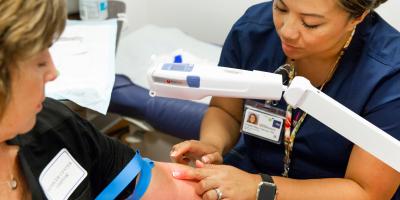
Participate in a Trial
How do I get started with joining a clinical trial?
To begin our screening process, please contact [email protected], (415) 476-0661 to let us know you are interested in learning more about clinical trials. Your contact information is added to our database, and we make every effort to contact you in in a timely fashion. This may take 1-2 weeks.
Our UCSF clinical trials team will schedule a phone screen call to discuss clinical trials that are open to enrollment, clarify any questions about the screening process and study procedures, including time commitment, risks, and benefits, and conduct a brief medical history review.
It is important to learn about the study before deciding to participate (see Things to Consider Before Participating in a Clinical Trial). Our research staff also asks questions to determine if the participant may potentially be eligible for a clinical trial. The phone screen takes about 20 minutes, or as long as needed to answer the participant’s questions.
I have completed the phone screen, what’s next?
The Research Coordinator will let you know next steps by email or telephone, depending on your preference. If after the phone screen, you are identified to be a possible candidate for a clinical trial, and you are still interested, we will send you two important documents:
- A sample consent form for you and your family to take review. The study doctor and research team are available to answer your questions after you’ve had an opportunity to review the consent document and contemplate study participation.
- A Release of Health Information Form. This form allows us to obtain your medical information with your permission. Once completed, please email, fax, or mail the form to your Research Coordinator. Your research coordinator will submit the form to your care providers. We ask that you complete a form for the main physicians you see annually. Your doctors’ offices will send us the records and our study doctors will be able to review for eligibility. Your research coordinator will keep you updated throughout this process. The medical records review may take up to 2-3 weeks to complete. Your Research Coordinator will notify you of the outcome of this review.
How long does the pre-screening process take?
On average, the full pre-screening process takes a month. The main way you can help is by ensuring the signed Release of Health Information form has been sent to your Research Coordinator. This prompts our team for medical record collection. Notifying your doctor that our team is going to be requesting records can also help. It is possible that the record collection process, alone, can take 2-3 weeks depending on the doctor’s office.
What happens during the study?
If you agree to join a study and the screening process shows you are a good match, you will first have a "baseline" visit with the study staff. This visit generally involves a full physical exam and extensive cognitive tests, which gives the study team information against which to measure future mental and physical changes. Participants may also receive the test drug or treatment at this time.
As the study progresses, participating patients and family members usually must follow strict medication or treatment instructions and keep detailed records of their symptoms. Every so often, participants will visit the research center to have physical and cognitive exams, brain scans, give biological samples (such as blood, urine, and/or spinal fluid samples), and talk with the study staff. These visits allow the investigators to assess the effects of the test drug or treatment, see how the disease is progressing, and check in on how the patient and the caregiver are doing.
In most clinical trials, participants will be randomly assigned to a study group (see About Clinical Trials). One group, the test group, receives the experimental drug. Other groups may receive a different drug, or a placebo (an inactive substance that looks like the study drug). Having these different groups is important because only by comparing them can researchers be confident that changes in the test group are the result of the experimental treatment and not some other factor.
In many trials, no one—not even the study team—knows who is getting the experimental drug and who is getting the placebo or the other drug. This is called "masking," meaning that both the patient/family and the staff are "blind" to the treatment being received.